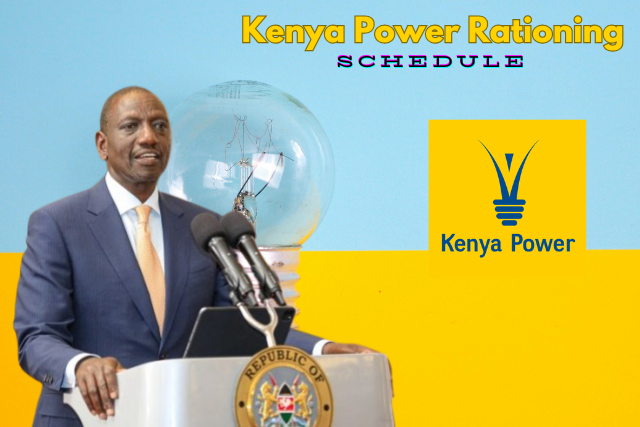
Kenya Power Rationing
Kenya Power Rationing Schedule Today, Causes, Updates, and Positive Solutions for Stable Electricity Supply
Kenya is currently experiencing electricity rationing in several regions, especially during peak evening hours. The kenya power rationing schedule has been announced to stabilize the national grid as demand grows. This situation has sparked nationwide conversations about Kenya’s energy future, reliability, and sustainable solutions.
Despite the concerns, there is a positive side. Kenya has a strong foundation in renewable energy and significant potential for long-term stability. By understanding the cause and the solutions, citizens and businesses can better prepare and adapt.
Why Kenya Is Experiencing Power Rationing

President William Ruto recently confirmed that kenya power rationing is now necessary between 5pm and 10pm daily in selected areas. This is to maintain grid stability as demand currently exceeds supply in some periods.
Major factors influencing this situation include:
- Increased electricity demand from industries and growing urban areas.
- Lower hydropower output during seasons of reduced rainfall.
- Limited backup power sources available at short notice.
As a result, kenya power load shedding schedules have been implemented to prevent nationwide blackouts. Kenya Power has been issuing kplc blackout areas today notices to keep customers informed.
This rationing is temporary, but it highlights the need for faster investment in energy generation and storage.
How Ethiopia Helped Kenya Reduce Blackout Risks
Kenya has made regional partnerships to stabilize supply. One notable step was importing power from Ethiopia’s hydropower plants.
This cooperation helped Kenya avoid deeper shortages and improved supply during peak demand periods. Reports show that how Ethiopia saved Kenya from power rationing blackouts is a strong example of regional energy collaboration.
Kenya is now planning to increase this imported capacity further. This strategy helps the country avoid heavy reliance on local hydropower during dry periods.
Checking the Kenya Power Rationing Schedule

KPLC continues to release daily updates. These updates can be found through:
- Kenya Power official website (Power interruption notices section).
- KPLC Twitter/X handle (@KenyaPower_Care).
- Local news bulletins under kenya power news today.
- Community WhatsApp and resident groups.
Search terms such as kenya power rationing today near Nairobi or kenya power electricity rationing today can help locate real-time updates.
The kenya power rationing schedule today and kenya power rationing schedule tomorrow are usually posted early in the day. Some counties may experience longer maintenance-based interruptions apart from rationing.
How Much Electricity Kenya Produces
Kenya currently generates over 3,300 MW of installed capacity. The biggest share comes from:
- Geothermal power
- Hydropower
- Wind power
- Thermal power (used less due to cost and emissions)
Geothermal energy is Kenya’s strongest advantage. Kenya is Africa’s leader in geothermal production and among the top globally. However, peak-time demand continues to grow faster than some power plants can respond.
What Percentage of Kenya Has Electricity
Electricity access in Kenya has grown significantly in the last decade. About 75% of households are now connected either through the national grid or off-grid solar systems. This is a positive achievement and shows strong national progress.
The challenge is ensuring stable supply to match expanding demand.

Read Also: How to Buy KPLC Shares
What Can Be Done to Improve the Situation
There are several positive pathways Kenya is already exploring:
1. Accelerate Renewable Energy Projects
More geothermal wells are being drilled. Wind and solar farms are also expanding. These projects reduce pressure during peak hours and lower electricity costs.
2. Increase Power Storage
Battery storage solutions help store power during off-peak hours. This stored power can be released when demand rises. This strategy is already used in advanced energy systems globally.
3. Diversify Regional Power Trade
Importing and exporting power among East African countries can stabilize supply year-round. This ensures no single country struggles alone with drought seasons or rising demand.
4. Encourage Smart Consumption
Households and businesses can shift heavy energy use to midday when supply is stable. This reduces pressure during the evening.
5. Educate on Power Consumption
Learning how to calculate power consumption in Kenya helps users avoid unnecessary usage and high billing. This also reduces load on the grid.
Positive Outlook of Kenya’s Energy Future Being Strong
Kenya is well-positioned to become Africa’s clean energy leader. The country already runs on over 80% renewable energy. The current power rationing in Kenya today highlights short-term challenges, but long-term progress continues.
Investments in geothermal, regional power trading, and grid upgrades show a pathway toward reliable electricity without dependence on thermal fuels.
With collaboration between government, citizens, and industries, Kenya can soon move beyond rationing into a new era of energy reliability and sustainability.

Read Also: How to Fix KPLC Paybill Not Working
Conclusion
The current Kenya Power rationing situation is understandably disruptive, but it is a temporary measure to protect the national grid. Kenya has the resources and strategy required to overcome the challenge. By expanding renewable sources, improving energy storage, and promoting responsible usage, the country can secure stable electricity for future generations.
Staying informed using the kenya power rationing schedule and official notices helps households and businesses plan better. The future remains bright for Kenya’s power sector, with growth and innovation leading the way forward.





